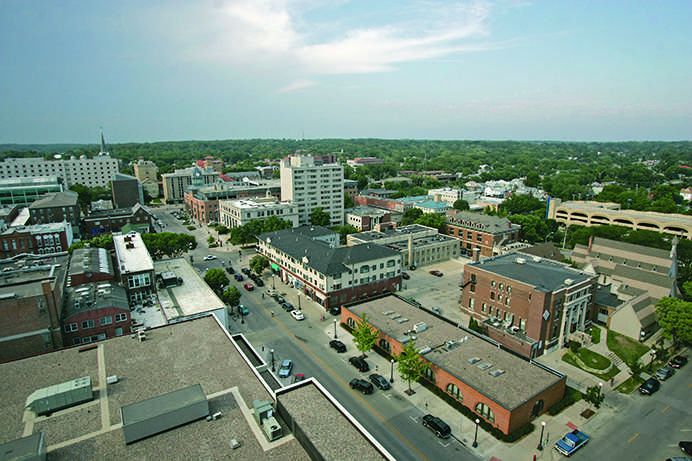Iowa City still remembers.
It has been 10 years since a tornado struck the city on April 13, 2006, shortly after 8 p.m.
“It was a beautiful spring day, kind of like today but a little hotter,” said Leslie Prideaux, a former president of Alpha Chi Omega, a sorority that was heavily damaged. “All of the sudden, the clouds just changed.”
Prideaux was a journalism student at the University of Iowa and was reporting on a New York Times writer at Van Allen Hall when the tornado struck the city. She said five minutes into her speech; audience members were moved to the basement to take shelter.
“During that time, I thought it was great so I could talk to her one on one,” she said. “But my phone kept vibrating, and you could start to hear hail and wind, it started to get really bad out.”
The roof and a wall of her sorority house was ripped off by the tornado, but she didn’t believe it at first, thinking it was just a joke her best friend was pulling on her.
“When she hung up on me, I was just like, ‘Oh, no,’ ” she said. “That’s when it really hit me what happened.”
The tornado, F2 on the scale, traveled four and a half miles over the course of 18 minutes; it initially touched down in the southwestern Iowa City near Walmart.
“I thought just a heavy storm passed over. I walked up the stairs and could see the sky,” said Scott McWane, the owner of the Dairy Queen, 526 S. Riverside Drive, which was also hit by the tornado. “It was surreal; I just couldn’t register that that much damage was done in that split second.”
McWane said the entire structure of the store was basically gone — the roof, the front glass, and the cinder blocks holding the small building located near the Iowa River.
When the tornado hit, McWane said, he rushed to the basement with two other employees and a few customers.
“After seeing and getting through it, it’s kind of like a miracle,” he said. “It’s amazing nobody was hurt.”
It was also Easter week when the tornado struck town.
The Rev. Rudolph Juarez of St. Patrick’s had just finished celebrating Mass on Holy Thursday with around 30 to 40 people when the tornado sirens began to echo across the city.
Juarez said he rushed everybody over to the nearby rectory, crowding into the basement.
“We got everybody lined up and went downstairs to the basement of the house. We were there for only 10 minutes,” he said.
Juarez says he heard a kind of “rumble” outside, which was the debris of buildings flying everywhere.
“You hear the noise and everything and think it’s quite a storm, but I never imagined how powerful it was,” Juarez said.
He said after the tornado moved on, he could feel the air pressure change “like a vacuum.” Reflecting on the day, he said, there was an “eerie silence” after everything.
“I looked out the window and could see daylight where the roof have been in the church,” he said. “I noticed the steeple was gone and the whole front wall of the church. I was shocked.”
The destruction caused $12 million in damages to 130 year-old St. Patrick Catholic Church, which had been located at 228 E. Court St. before being destroyed by the tornado.
Now, the rededicated church sits at 4330 St. Patrick Drive, with a brand-new social hall, classrooms, gymnasium, and seating for more than 1,000 people.
“I think at the time what we thought what was a disaster was a big blessing,” Juarez said. “I don’t think of it of any great sadness because I’m grateful nobody lost their lives. It could’ve been terrible.”
All the buildings were unsalvageable and were scheduled for demolition.
David Grady, the former UI dean of students, took action in arranging shelter for students in collaboration with faculty and staff.
“The next day, the Sun came up and just walking around and seeing the devastation that occurred, we knew the university had to be there to provide support,” he said.
UI staff and faculty were able to set up an emergency center provided by the American Red Cross in the IMU Second-Floor Ballroom for those in need, while the Iowa House Hotel opened its doors for the displaced as well.
“I was just super grateful that no one got hurt,” Prideaux said. “Times like that crisis always happen for reason. It changed all of our lives and made us realize how important to each other we are.”



